| Oxysterol-binding protein | |||||||||
|---|---|---|---|---|---|---|---|---|---|
 Crystallographic structure of the oxysterol-binding protein (rainbow color cartoon, N-terminus = blue, C-terminus = red) bound to 7-hydroxycholesterol (stick diagram, carbon = white, oxygen = red).[1] | |||||||||
| Identifiers | |||||||||
| Symbol | Oxysterol_BP | ||||||||
| Pfam | PF01237 | ||||||||
| InterPro | IPR000648 | ||||||||
| PROSITE | PDOC00774 | ||||||||
| OPM superfamily | 164 | ||||||||
| OPM protein | 1zi7 | ||||||||
| Membranome | 484 | ||||||||
| |||||||||
The oxysterol-binding protein (OSBP)-related proteins (ORPs) are a family of lipid transfer proteins (LTPs). Concretely, they constitute a family of sterol and phosphoinositide binding and transfer proteins in eukaryotes[2] that are conserved from yeast to humans. They are lipid-binding proteins implicated in many cellular processes related with oxysterol, including signaling, vesicular trafficking, lipid metabolism, and nonvesicular sterol transport.
In yeast cells, some ORPs might function as sterol or lipid transporters though yeast strains lacking ORPs do not have significant defects in sterol transport between the endoplasmic reticulum and the plasma membrane.[3] Although sterol transfer is proposed to occur at regions where organelle membranes are closely apposed, disruption of endoplasmic reticulum-plasma membrane contact sites do not have major effects on sterol transfer, though phospholipid homeostasis is perturbed.[4] Various ORPs confine at membrane contacts sites (MCS), where endoplasmic reticulum (ER) is apposed with other organelle limiting membranes. Yeast ORPs also participate in vesicular trafficking, in which they affect Sec14-dependent Golgi vesicle biogenesis[5] and, later in post-Golgi exocytosis, they affect exocyst complex-dependent vesicle tethering to the plasma membrane.[6] In mammalian cells, some ORPs function as sterol sensors that regulate the assembly of protein complexes in response to changes in cholesterol levels.[7] By that means, ORPs most likely affect organelle membrane lipid compositions, with impacts on signaling and vesicle transport, but also cellular lipid metabolism.[8]
Oxysterol is a cholesterol metabolite that can be produced through enzymatic or radical processes. Oxysterols, that are the 27-carbon products of cholesterol oxidation by both enzymic and non-enzymic mechanisms, constitute a large family of lipids involved in a plethora of physiological processes. Studies identifying the specific cellular targets of oxysterol indicate that several oxysterols may be regulators of cellular lipid metabolism via control of gene transcription. In addition, they were shown to be involved in other processes such as immune regulatory functions and brain homeostasis.[9][10]
Structure
.png.webp)
All oxysterol related proteins (ORP) contain a core lipid-binding domain (ORD), which has a characteristic amino acids sequence, EQVSHHPP. The most studied ORP are human and yeast ones, and the only OSBP-ORP whose structure is completely known is the Kes1p, also called Osh4p, a yeast one. Six different protein domains and structural motifs types are found in OSBP-ORPs.[11]
.png.webp)
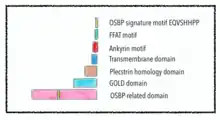
FFAT motif
This is two phenylalanines in an acidic tract. It is bound by the endoplasmic reticulum to a lot of proteins involved in lipid metabolism. It is contained in most mammalian ORPs and in about 40% of yeast's ORPs.
Ankyrin motif
It is thought that it takes part in protein-protein interactions, but it is not known for certain. In some proteins, it also contributes to the localization of each protein to a membrane contact site (zone of close contact between the endoplasmic reticulum and a second organelle).
Transmembrane domain
It is only present in some human proteins. It is a hydrophobic region which holds the protein to the cell membrane.
PH (pleckstrin homology) domain
It binds phosphoinositides, usually only the ones which have low affinity and other ligands. It also recognizes organelles enriched in the PIPs.
GOLD (Golgi dynamics) domain
As well as Ankyrin motif, it probably mediates interactions between proteins. It is only found in one yeast protein and it is not found in any human ORP.
ORD (OSBP-related domain)
It contains the EQVSHHPP sequence. It has an hydrophobic pocket that binds a sterol and also contains multiple membrane binding surfaces which permit the protein to have the ability to cause liposome aggregation.
Main functions
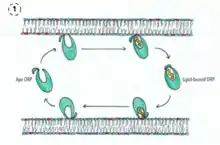
As part of the Lipid Transfer proteins (LTPs) family, ORPs have different and variate functions. This functions include signaling, vesicular trafficking, lipid metabolism and nonvesicular sterol transport.[12] ORPs have been studied in many organisms cells as human cells or yeast. In yeast, where organelle membranes are closely apposed it has been proposed that ORPs work as sterol transporters, though only a few ORPs actually bind sterols and collectively yeast ORPs are dispensable for sterol transfer in vivo. They are also part of Golgi-to-plasma membrane vesicular trafficking, but their role is not clear yet. In mammalian, ORPs participate as sterol sensors. This sensors regulate the assembly of protein complexes when cholesterol levels fluctuate.[13]

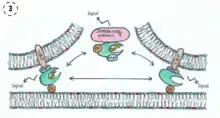
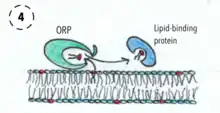
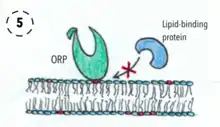
They use the following mechanisms:
1-They could extract and deliver lipids from one membrane to another. Probably at membrane contact site.
2-ORPs help establish the membrane when transient changes in the distribution of lipids occur. They add or remove lipids within different regions of the membrane. The exclusion of certain lipids in particular regions drive to processes such as membrane binding or signaling.
3-They work as lipid sensors altering interactions with other proteins due to binding or releasing lipid ligands. It occurs mainly at inally organelle contact sites.
4-The access of other lipid-binding proteins to the membrane is regulated by ORPs in two ways. One way is by presenting a lipid to a second lipid-binding protein. (5)Another way is preventing the lipid-binding protein from accessing a lipid in the membrane. This two mechanisms are not mutually exclusive so ORPs might use both.
OSBP-ORPs human proteins
In humans there are 12 ORP genes, and splicing generates 16 different protein products.[14][15] [16]
| Symbol | Name | Length (aa) | Chromosome | Molecular function |
|---|---|---|---|---|
| OSBP [17]
(OSBP1) | Oxysterol-binding protein 1 | 807 | 11q12.1 |
|
| OSBP2 [18]
(KIAA1664, ORP-4, ORP4) | Oxysterol-binding protein 2 | 916 | 22q12.2 |
|
| OSBPL1A [19]
(ORP-1, ORP1) | Oxysterol-binding protein-related protein 1 | 950 | 18q11.2 |
|
| OSBPL2 [20]
"(KIAA0772, ORP2)" [21] |
Oxysterol-binding protein-related protein 2 | 480 | 20q13.33 |
|
| OSBPL3 [22]
(ORP-3, ORP3, KIAA0704) | Oxysterol-binding protein-related protein 3 | 887 | 7p15.3 |
|
| OSBPL5 [23]
(KIAA1534, ORP5) | Oxysterol-binding protein-related protein 5 | 879 | 11p15.4 |
|
| OSBPL6 [24]
(ORP6) | Oxysterol-binding protein-related protein 6 | 934 | 2q31.2 |
|
| OSBPL7 [25]
(ORP7, MGC71150) | Oxysterol-binding protein-related protein 7 | 842 | 17q21 |
|
| OSBPL8 [26]
(OSBP10, ORP8, MST120, MSTP120) | Oxysterol-binding protein-related protein 8 | 889 | 12q14 |
|
| OSBPL9 [27]
(ORP9, OSBP4) | Oxysterol-binding protein-related protein 9 | 736 | 1p32.3 |
|
| OSBPL10 [28]
(ORP10, OSBP9) | Oxysterol-binding protein-related protein 10 | 764 | 3p23 |
|
| OSBPL11 [29]
(ORP-11, ORP11, FLJ13012, FLJ13164) | Oxysterol-binding protein-related protein 11 | 747 | 3q21.2 |
|
OSBP-ORPs yeast proteins
In yeast (Saccharomyces cerevisiæ) we can find 7 ORP genes called OSH1-7, but they have some additional names as well.[30][31]
| Symbol | Name | Length (aa) | Molecular function | Subcellular location |
|---|---|---|---|---|
| OSH1 [32]
(SWH1, YAR042W, YAR044W) | Oxysterol-binding protein homolog 1 | 1188 |
|
|
| OSH2 [33]
(YDL019C, D2845) | Oxysterol-binding protein homolog 2 | 1283 |
|
|
| OSH3 [34]
(YHR073W) | Oxysterol-binding protein homolog 3 | 996 |
|
|
| OSH4 [35]
(KES1, YPL145C, LPI3C, P2614) | Oxysterol-binding protein homolog 4 | 434 |
|
|
| OSH5 [36]
(HES1, YOR237W, O5234) | Oxysterol-binding protein homolog 5 | 434 |
| - |
| OSH6 [37]
(YKR003W, YK102) | Oxysterol-binding protein homolog 6 | 448 |
|
|
| OSH7 [38]
(YHR001W) | Oxysterol-binding protein homolog 7 | 437 |
|
|
Role in disease
Some oxysterols have been found to contribute to the inflammation and oxidative damage as well as in cell death in the appearance and especially the development of some of the most important chronic diseases, such as atherosclerosis, neurodegenerative diseases, inflammatory bowel diseases, age-related macular degeneration and other pathological conditions related to cholesterol absorption.[39]
Besides, a recent study suggests a method of screening and diagnosing Niemann-Pick C disease by plasma oxysterol screening, which is found to be less invasive, more sensitive and specific and more economical strategy than the current practice.[40]
References
- ↑ PDB: 1ZHT; Im YJ, Raychaudhuri S, Prinz WA, Hurley JH (September 2005). "Structural mechanism for sterol sensing and transport by OSBP-related proteins". Nature. 437 (7055): 154–8. Bibcode:2005Natur.437..154I. doi:10.1038/nature03923. PMC 1431608. PMID 16136145.
- ↑ Weber-Boyvat M, Zhong W, Yan D, Olkkonen VM (July 2013). "Oxysterol-binding proteins: functions in cell regulation beyond lipid metabolism". Biochemical Pharmacology. 86 (1): 89–95. doi:10.1016/j.bcp.2013.02.016. PMID 23428468.
- ↑ Georgiev, AG (2011). "Osh proteins regulate membrane sterol organization but are not required for sterol movement between the ER and PM". Traffic. 12 (10): 1341–55. doi:10.1111/j.1600-0854.2011.01234.x. PMC 3171641. PMID 21689253.
- ↑ Quon, E (2018). "Endoplasmic reticulum-plasma membrane contact sites integrate sterol and phospholipid regulation". PLOS Biology. 16 (5): e2003864. doi:10.1371/journal.pbio.2003864. PMC 5983861. PMID 29782498.
- ↑ Li, X (April 2002). "Analysis of oxysterol binding protein homologue Kes1p function in regulation of Sec14p-dependent protein transport from the yeast Golgi complex". J. Cell Biol. 157 (1): 63–77. doi:10.1083/jcb.200201037. PMC 2173257. PMID 11916983.
- ↑ Alfaro, G (2011). "The sterol-binding protein Kes1/Osh4p is a regulator of polarized exocytosis". Traffic. 12 (11): 1521–36. doi:10.1111/j.1600-0854.2011.01265.x. PMID 21819498.
- ↑ Raychaudhuri S, Prinz WA (10 November 2010). "The diverse functions of oxysterol-binding proteins". Annual Review of Cell and Developmental Biology. 26: 157–77. doi:10.1146/annurev.cellbio.042308.113334. PMC 3478074. PMID 19575662.
- ↑ Weber-Boyvat M, Zhong W, Yan D, Olkkonen VM (July 2013). "Oxysterol-binding proteins: functions in cell regulation beyond lipid metabolism". Biochemical Pharmacology. 86 (1): 89–95. doi:10.1016/j.bcp.2013.02.016. PMID 23428468.
- ↑ Mutemberezi V, Guillemot-Legris O, Muccioli GG (October 2016). "Oxysterols: From cholesterol metabolites to key mediators". Progress in Lipid Research. 64: 152–169. doi:10.1016/j.plipres.2016.09.002. PMID 27687912.
- ↑ van Reyk DM, Brown AJ, Hult'en LM, Dean RT, Jessup W (1 January 2006). "Oxysterols in biological systems: sources, metabolism and pathophysiological relevance". Redox Report. 11 (6): 255–62. doi:10.1179/135100006X155003. PMID 17207307.
- ↑ Raychaudhuri S, Prinz WA (10 November 2010). "The diverse functions of oxysterol-binding proteins". Annual Review of Cell and Developmental Biology. 26: 157–77. doi:10.1146/annurev.cellbio.042308.113334. PMC 3478074. PMID 19575662.
- ↑ Ngo M, Ridgway ND (March 2009). "Oxysterol binding protein-related Protein 9 (ORP9) is a cholesterol transfer protein that regulates Golgi structure and function". Molecular Biology of the Cell. 20 (5): 1388–99. doi:10.1091/mbc.E08-09-0905. PMC 2649274. PMID 19129476.
- ↑ Raychaudhuri S, Prinz WA (10 November 2010). "The diverse functions of oxysterol-binding proteins". Annual Review of Cell and Developmental Biology. 26: 157–77. doi:10.1146/annurev.cellbio.042308.113334. PMC 3478074. PMID 19575662.
- ↑ Lehto M, Laitinen S, Chinetti G, Johansson M, Ehnholm C, Staels B, Ikonen E, Olkkonen VM (August 2001). "The OSBP-related protein family in humans". Journal of Lipid Research. 42 (8): 1203–13. doi:10.1016/S0022-2275(20)31570-4. PMID 11483621.
- ↑ "Oxysterol binding proteins (OSBP) Gene Family | HUGO Gene Nomenclature Committee". www.genenames.org. Retrieved 11 October 2016.
- ↑ ""oxysterol binding" proteins in UniProtKB". www.uniprot.org. Retrieved 11 October 2016.
- ↑ Universal protein resource accession number P22059 for "OSBP - Oxysterol-binding protein 1 - Homo sapiens (Human)" at UniProt.
- ↑ Universal protein resource accession number Q969R2 for "Oxysterol-binding protein 2 - Homo sapiens (Human)" at UniProt.
- ↑ Universal protein resource accession number Q9BXW6 for "OSBPL1A - Oxysterol-binding protein-related protein 1 - Homo sapiens (Human)" at UniProt.
- ↑ Universal protein resource accession number Q9H1P3 for "OSBPL2 - Oxysterol-binding protein-related protein 2 - Homo sapiens (Human)" at UniProt.
- ↑ Escajadillo T, Wang H, Li L, Li D, Sewer MB (May 2016). "Oxysterol-related-binding-protein related Protein-2 (ORP2) regulates cortisol biosynthesis and cholesterol homeostasis". Molecular and Cellular Endocrinology. 427: 73–85. doi:10.1016/j.mce.2016.03.006. PMC 4833515. PMID 26992564.
- ↑ Universal protein resource accession number Q9H4L5 for "OSBPL3 - Oxysterol-binding protein-related protein 3 - Homo sapiens (Human)" at UniProt.
- ↑ Universal protein resource accession number Q9H0X9 for "OSBPL5 - Oxysterol-binding protein-related protein 5 - Homo sapiens (Human)" at UniProt.
- ↑ Universal protein resource accession number Q9BZF3 for "OSBPL6 - Oxysterol-binding protein-related protein 6 - Homo sapiens (Human)" at UniProt.
- ↑ Universal protein resource accession number Q9BZF2 for "OSBPL7 - Oxysterol-binding protein-related protein 7 - Homo sapiens (Human)" at UniProt.
- ↑ Universal protein resource accession number Q9BZF1 for "OSBPL8 - Oxysterol-binding protein-related protein 8 - Homo sapiens (Human)" at UniProt.
- ↑ Universal protein resource accession number Q96SU4 for "Oxysterol-binding protein-related protein 9 - Homo sapiens (Human)" at UniProt.
- ↑ Universal protein resource accession number Q9BXB5 for "Oxysterol-binding protein-related protein 10 - Homo sapiens (Human)" at UniProt.
- ↑ Universal protein resource accession number Q9BXB4 for "OSBPL11 - Oxysterol-binding protein-related protein 11 - Homo sapiens (Human)" at UniProt.
- ↑ Beh CT, Cool L, Phillips J, Rine J (March 2001). "Overlapping functions of the yeast oxysterol-binding protein homologues". Genetics. 157 (3): 1117–40. doi:10.1093/genetics/157.3.1117. PMC 1461579. PMID 11238399.
- ↑ ""oxysterol binding" proteins in UniProtKB". www.uniprot.org. Retrieved 17 October 2016.
- ↑ Universal protein resource accession number P35845 for "SWH1 - Oxysterol-binding protein homolog 1 - Saccharomyces cerevisiae (strain ATCC 204508 / S288c) (Baker's yeast)" at UniProt.
- ↑ Universal protein resource accession number Q12451 for "OSH2 - Oxysterol-binding protein homolog 2 - Saccharomyces cerevisiae (strain ATCC 204508 / S288c) (Baker's yeast)" at UniProt.
- ↑ Universal protein resource accession number P38713 for "OSH3 - Oxysterol-binding protein homolog 3 - Saccharomyces cerevisiae (strain ATCC 204508 / S288c) (Baker's yeast)" at UniProt.
- ↑ Universal protein resource accession number P35844 for "Oxysterol-binding protein homolog 4 - Saccharomyces cerevisiae (strain ATCC 204508 / S288c) (Baker's yeast)" at UniProt.
- ↑ Universal protein resource accession number P35843 for "Protein HES1 - Saccharomyces cerevisiae (strain ATCC 204508 / S288c) (Baker's yeast)" at UniProt.
- ↑ Universal protein resource accession number Q02201 for "OSH6 - Oxysterol-binding protein homolog 6 - Saccharomyces cerevisiae (strain ATCC 204508 / S288c) (Baker's yeast)" at UniProt.
- ↑ Universal protein resource accession number P38755 for "OSH7 - Oxysterol-binding protein homolog 7 - Saccharomyces cerevisiae (strain ATCC 204508 / S288c) (Baker's yeast)" at UniProt.
- ↑ Poli G, Biasi F, Leonarduzzi G (January 2013). "Oxysterols in the pathogenesis of major chronic diseases". Redox Biology. 1 (1): 125–30. doi:10.1016/j.redox.2012.12.001. PMC 3757713. PMID 24024145.
- ↑ van Karnebeek CD, Mohammadi T, Tsao N, Sinclair G, Sirrs S, Stockler S, Marra C (February 2015). "Health economic evaluation of plasma oxysterol screening in the diagnosis of Niemann-Pick Type C disease among intellectually disabled using discrete event simulation". Molecular Genetics and Metabolism. 114 (2): 226–32. doi:10.1016/j.ymgme.2014.07.004. PMID 25095726.